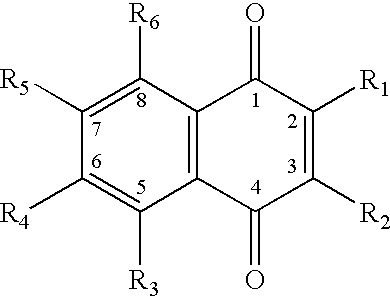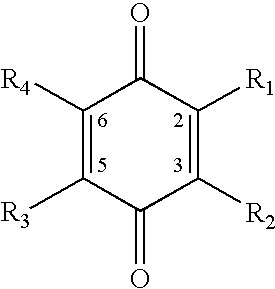Method of controlling zoological and aquatic plant growth
a technology for controlling zoological and aquatic plant growth, applied in the direction of biocide, heterocyclic compound active ingredients, biocide, etc., can solve the problems of affecting the integration of the coastal waters of the united states and the great lakes basin, affecting the quality of life of fisheries and other natural resources,
- Summary
- Abstract
- Description
- Claims
- Application Information
AI Technical Summary
Benefits of technology
Problems solved by technology
Method used
Image
Examples
example 15
[0118]Banana snails (Bulimulis alternata) were obtained from a commercial supplier and were fed lettuce leaves until the start of the bioassay.
[0119]Ten snails were placed in covered 1 liter glass beakers, on approximately 50 cm2 lettuce leaves which had been sprayed with a fine mist of an aqueous solution of 2,3-dimethoxy-5-methyl-1,4-benzoquinone at three concentrations: 5, 10 and 20 mg / l. The treated leaves were allowed to dry before exposure to the snails. 10 snails were placed on approximately 50 cm2 of untreated lettuce leaf as a control. Treatments and controls were maintained at approximately 20° C. in the dark. They were observed at 24 and 48 hours for signs of mortality and feeding activity.
[0120]In all treatments, the snails demonstrated significant avoidance relative to control. Several snails of the treatment group withdrew into their shells and exhibited no feeding activity at all (leaves were completely intact). Others climbed up the walls of the beakers away from the...
PUM
| Property | Measurement | Unit |
|---|---|---|
| Time | aaaaa | aaaaa |
| Fraction | aaaaa | aaaaa |
| Fraction | aaaaa | aaaaa |
Abstract
Description
Claims
Application Information
 Login to View More
Login to View More - R&D
- Intellectual Property
- Life Sciences
- Materials
- Tech Scout
- Unparalleled Data Quality
- Higher Quality Content
- 60% Fewer Hallucinations
Browse by: Latest US Patents, China's latest patents, Technical Efficacy Thesaurus, Application Domain, Technology Topic, Popular Technical Reports.
© 2025 PatSnap. All rights reserved.Legal|Privacy policy|Modern Slavery Act Transparency Statement|Sitemap|About US| Contact US: help@patsnap.com



